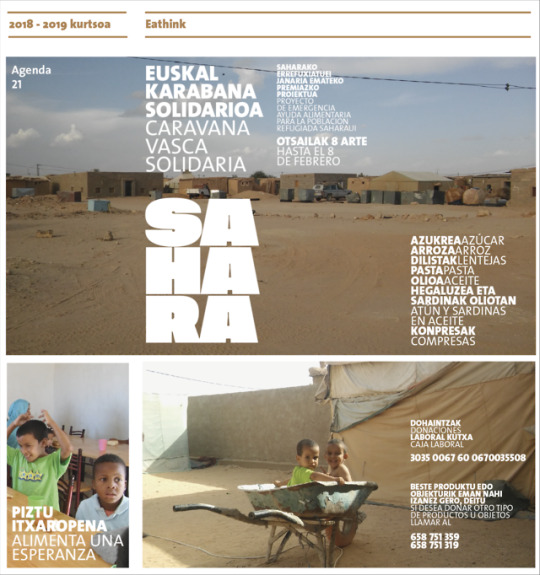#karabana
Text
Spotlight: The Obi of Sakkō






On The Twelfth Day of Fun I present... another spotlight! Someone actually did an ask about iconic obi, and to me there's no obi more iconic than those worn during the sakkō period.
While the sakkō outfits of each kagai may differ, there's one constant that remains the same: stunning obi with golden threads to celebrate the special occasion. Most tend to have white as a base, but others will incorporate other colors like beige, gold, taupe, or some shade close to gold. In other rare occasions you'll even see bold colors such as green or black; there's no strict rules when it comes to sakkō!
Gold is the color of wealth and celebrations, so its abundance is auspicious and a wish for much luck in the future. The motifs on the obi tend to be auspicious as well, with karabana (imaginary flowers) being quite popular as they're both beautiful and unique as no two designs are identical.
In some cases certain okiya will use the same outfits specifically for their sakkō periods, so we'll see certain obi used just for this period. Sometimes okiya will even use specific obi for specific naming lines if they have more than one under their roof. Other times okiya will choose their finest obi and pair it with their sakkō kimono. The combinations are almost endless and the traditions are unique from one okiya to the next, even within the same district!
Image Credits
Koeri (小衿)
Mamekinu (まめ衣)
Katsuki (勝貴)
Fukusono (ふく苑)
Kanako (叶子)
Tomitae (富多愛)
81 notes
·
View notes
Text
Adhesiones colectivas
Federación Unión Africana España
València és Refugi
Asociación Intercultural Candombe
Jarit Associació Civil
Obrint Fronteres
Plataforma Intercultural de España
Sillas contra el hambre
Entreiguales Valencia
Comunidades Cristianas Populares Valencia
Equipo de Implementación del Decenio Afrodescendiente en España
L’ElianaVol
Colectivo Sin Fronteras Albacete
VIVIR POÉTICAMENTE
Red SOS Refugiados Europa
Asociacion Popular De Vendedores Ambulantes De Barcelona
Baladre. Coordinacion de luchas contra la exclusion social
Zambra Málaga
Asociación Cultural Brasileña Maloka
RegularizaciónYa
Asociación Afromurcia
Cnaee Murcia
La Floresta Contra Fronteras
Colectivo Pacifistas Ciudad Real
Coordinadora Obrera Sindical COS l'Horta
Zambra Málaga
Asociado Stolpersteine
Familiares victimas del franquismo fosa 128 de Paterna
Asociación de los Cameruneses en Valencia
Asociación Cultural LoQueSomos
Ongi etorri errefuxiatuak araba
LluísVicent&LaFree&Feelin'Band
Plataforma Bienvenid@s Refugiad@s de La Rioja
Iai@flautas Valencia
Asociacion Papeles y derechos para todas y todos
Mulheres brasileiros contra o fascismo
Asociación palestina Biladi
Karabana Mugak Zabalduz Nafarroa
ASC la Desbandá
ONGI ETORRI ERREFUXIATUAK
Móstoles sin Fronteras
Plataforma Pro Refugiadxs Alto Aragon
Coletivo pelos Direitos no Brasil - Madrid
Encuéntame en Las Ondas
Trawunche Madrid (Coordinación de apoyo al pueblo Mapuche)
Evolución Rural
Asamblea Antimilitarista de Madrid
SOS Refugiados Guindalera
Lliga dels Drets dels Pobles
Caravana Obrim Fronteres
La casa de mi tía
Emergencia Frontera Sur Motril
Umoya Logroño
Solidary Wheels
COMITES DE SOLIDARIDAD CON AFRICA NEGRA -UMOYA
Centro de Documentación sobre Zapatismo -CEDOZ
L'Elianavol
CIEs NO Madrid
Avanazamos Ganando Igualdad
Asamblea Plaza de los Pueblos
Amigos de la no violencia
Obrim Fronteres Valencia
Misscomadres
Amigos de la Tierra
Esquerra Republicana del País Valencià-ERPV
FRATERNIDAD MISIONERA VERBUM DEI
Centro d Defensa y Estudio d los Derechos Humanos (CEDEHU)
CEDSALA (Centre de Documentació i Solidaritat amb Amèrica Llatina i Àfrica)
Espacio Común 15M
Derechos Humanos Madrid
Acción poética refugiados Valencia
CCOO de La Rioja
Mon sense guerres i sense violencia
Stop Mare Mortum Sants, Hostafrancs i la Bordeta. Barcelona
CEUNA-FAAM
BDS Madrid
Federación de Asociaciones Africanas de Murcia
SOV CGT Alcázar de San Juan
Bienvenidxs Refugiadxs Huesca
Colectivo Sirirí: Mujeres Migrantes Creando
Frente Antiimperialista INternacionalista
Red interlavapies
Asociación Social Combativa
Vangarda Obreira
Avis Mundi
Asociación Morvedre Acull Sagunt Camp de Morvedre
Comunidades Cristianas Populares de Andalucía
Burgos con bici
Errátikas contra el racismo
ASNUCI. Asociación nueva ciudadanía por la interculturalidad
Seminario de Mujeres Mujer Latinoamericana-Mujer Andaluza
Diapó con África
La Casa de Julién y Milagro (en formación)
Coordinadora en Defensa de la Sanidad Pública de la Asamblea de Barrios y Pueblos de Madrid
Granada Visible
Observatorio de Derechos Humanos Samba Martine
Sarrià Sant Gervasi Refugi
Red Granadina por el Refugio y la Acogida (Redgra)
PVSPS (Plataforma Valenciana de Solidaridad con el Pueblo Saharahui)
CNT Comarcal Sur Madrid
Proces Constituent
CGT Andalucía, Ceuta y Melilla
Comunidad La Esperanza Logroño
La Casa Azul de Valdepares (Navia, Asturias)
Plataforma Prorrefugiadxs Badajoz
Adhesiones individuales
Carmen Porta
Esperanza Nuñez Perez
Adama seide
M Lourdes Mondria Saez
Luisa Herrera
Harrison falla
Rosa Isabel Fernández Ceballos
Lola Juan Soler
Pascual Moreno Torregrosa
Maria Dantas (diputada Congreso)
Ángel González
Arantza Lucas Ortega
Tere Sáez
Pedro Serrano Barquero
Antonio Palacios Rojo
Isabel Pereda
Rosa Saez
M. Sagrario Pérez Mochales
María Cruz Vallespi Zambudio
Alberto Azcarate
Eladio Martín
Julio González Baltasar
Carmen López
Ana Blanco Castro
José Carlos Martínez-Blay Medrano
Txema Alcega
Pilar Soler Torroja
M Mar Pérez
Rosa Bajo
Amanda Maya Peñuelas Chuffart
Alfonso Mascuñana
Adela Jimenez Villarejo
Angela Vallina de la Noval
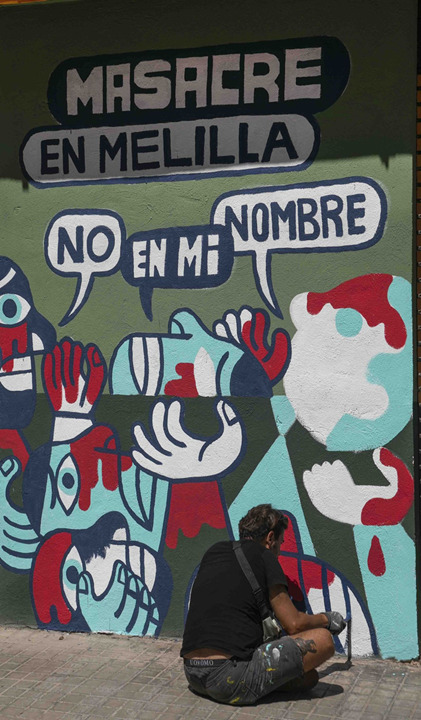
1 note
·
View note
Photo

#inktober day 18 - #imaginaryflowers #唐花 #karabana
3 notes
·
View notes
Photo

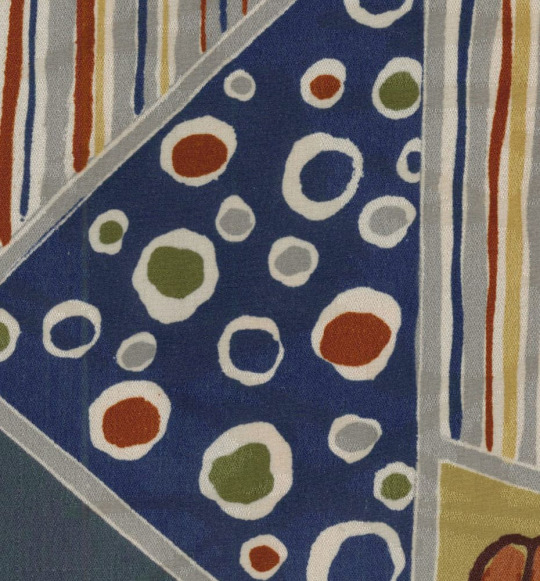
Late Meiji period (1900-1912). A rinzu (damask) silk kimono featuring imaginary "karabana" flowers.
133 notes
·
View notes
Photo
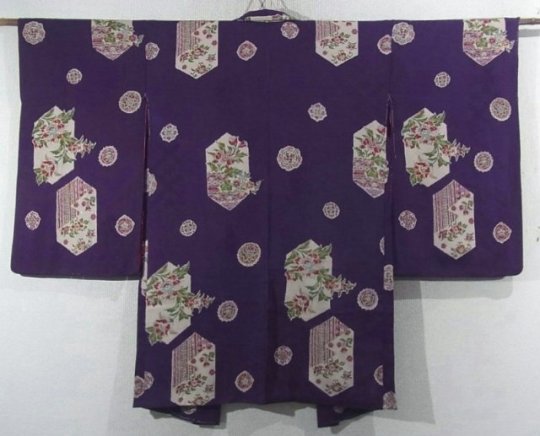
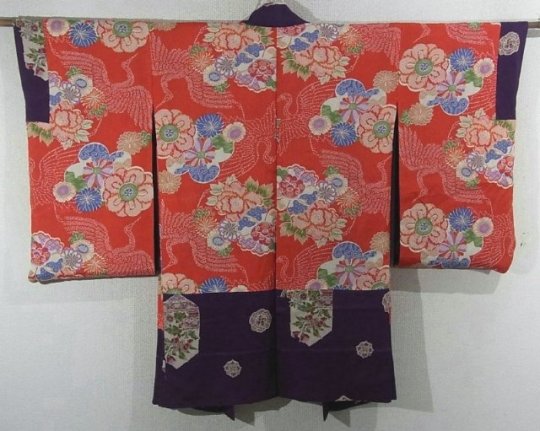
Koikishu’s Fantasy Kimono Tansu: Haori - Tomesode
Motifs: Karabana (Imaginary Chinese Flower), Tortoiseshell, Flower Circles, Shippou (Interlocking Circles), Hanabishi (Flower Diamonds), Plum Blossoms, Peony, Cranes
Seasonality: Seasonless
Sleeve Length: 64 cm
Background Color: HTML code 4A1E6B
Source: https://www.ichiroya.com/item/list2/474259/
22 notes
·
View notes
Text
Nampō Roku, Book 5 (52): Midare-kazari [亂飾] for the Large Maru-bon¹, [One] of Three [Arrangements].

52) Dai maru-bon midare-kazari mitsu no uchi [大丸盆亂飾三ツ之内]².

[The writing (above the daisu) reads³: temmoku dai ni noru (天目臺ニノル)⁴, sasa-mimi (サヽ耳), natsume (ナツメ), chashaku (茶杓), habōki (羽帚), fukusa (フクサ); (between the ten-ita and the ji-ita, beneath the kae-chawan) kaku no gotoki chashaku kae-wan ni mo kumi-iri, kurushi-karazu (如此茶杓・カヘ碗ニモクミ入、不苦)⁵.]
The kaki-ire [書入]⁶:
① This is the same as in the midare arrangement displayed on the shaku-naga[bon]. However, the shaku-naga is shin [眞], while the dai maru-bon has the feeling of gyō [行], so it is said⁷.
The fukusa-mono is folded [to resemble] a butterfly. There are female and male [versions]: [these details are discussed in a] ku-den⁸.
② Because the dai maru-bon is a gyō [行] utensil, on certain occasions when the incense utensils are displayed on a kō-bon [香盆] on the upper level [of the daisu], incense utensils should not be displayed [simultaneously]⁹.
[For example,] when showing appreciation to a famous incense burner (and on other occasions of that sort), following the meal a [dai] maru-bon is brought out on which are placed the chaire, chawan, chashaku, chakin, [and] chasen -- carried out as a single unit¹⁰.
On this occasion, the temmoku [tied] in its fukuro, ,[resting on its] dai, may also be on the tray when it is carried out¹¹. Or else the tea utensils may be [brought out one by one and] arranged on the tray, while the guests are still in the room¹².
Things like a temmoku or chaire that have a name should never be [included] in [this kind of practice]: ordinary utensils should suffice¹³. And again, if it is an ordinary chawan that has been prepared, it is likewise acceptable for it to be resting on the tray when [the dai maru-bon] is carried out.
③ Also, a natsume [or other kind of] chaire may be [placed] inside the chawan. When [the natsume] is stacked inside [the chawan], the chakin and chasen should be [arranged on the tray] separately¹⁵.
There is also the case where this is all done in front of the guests -- with the objects [finally] arranged as shown [in the sketch]¹⁶.
_________________________
◎ This arrangement, and the other two* that constitute this series of three midare-kazari, were a legitimate part of Jōō's original collection.
The fact that no incense things are included on the tray in the present arrangement should not confuse the reader†, since this is the way the things were arranged on the tray when it was brought out after the appreciation of incense had been concluded.
This entry provides us with a good, contemporary description of how the Shino family conducted their gatherings‡.
__________
*Unfortunately, the page on which the third of the three arrangements was drawn was torn when the manuscript came into Tachibana Jitsuzan's hands, meaning that it is not possible to determine the precise kazari that it depicted (though, most likely, it was another form of cha・kō kazari [茶・香飾], like the second one).
†This final section of the first part of Book Five is, as has been mentioned before, devoted to the cha・kō [茶・香] arrangements employed by the Shino family during their incense-appreciation gatherings (at which tea was also served -- during the goza), and the second kaki-ire explains one way that this was done: the dai maru-bon was brought out from the katte (with the tea utensils arranged in a manner resembling what is shown in the sketch) after the appreciation of incense, and the meal, had been concluded (since, at their more formal gatherings, the Shino apparently felt it was best not to mix the tea things with the incense things at the beginning of the shoza), indicating that tea would be served when the guests returned from the naka-dachi.
Unlike the modern (and ancient) gaming format, the Shino family preferred to focus their gatherings on the smelling of just one or two varieties of kyara [伽羅] incense as a way to enter samadhi (via the purification of the olfactory sense). The preparation and taking of tea, then, was completely aligned with their objectives (since tea is best appreciated when host and guests have all entered the state of samadhi -- while the intervening meal would serve to protect the stomach from being overwhelmed by the tea).
Unfortunately, the history of chanoyu was rewritten in the Edo period, with the objective being to emphasize the “purity” of the various arts. Thus, since the Shino family (or, rather, the group of Japanese adherents who carried on the name after the original Korean line became extinct) was most closely associated with incense (Shino Sōshin had been Yoshimasa's incense master -- an idea appropriated by the machi-shū practitioners of chanoyu who, later, asserted that Shukō had been Yoshimasa's tea master, even though it is indisputable that Yoshimasa learned chanoyu from Nōami; meanwhile, the original Shino family continued to do things according to their own understanding of the practice of chanoyu on the continent), their impact on chanoyu (it appears that Jōō actually learned his basic techniques by observing what the Shino were doing) was emphatically ignored.
‡Perhaps the text of the second kaki-ire was written by Jōō himself.
¹Large maru-bon.
The dai maru-bon [大丸盆] measured 1-shaku 3-sun in diameter, and was the largest of the six meibutsu trays (selected by Nōami for Yoshimasa to use) that could be lowered to the mat during the temae. In fact, the orientation of the daisu on the utensil mat was determined by this tray: the dai maru-bon was placed so that its front edge touched the middle of the mat, and the daisu was then placed so that it touched the far side of the tray. This left a space of 4-sun 5-bu on the far side; and the host sat 1-sun below the middle of the mat*.
The original tray featured a design of karabana [唐花], “Chinese flowers,” within a doubled-vine (futae-zuru [二重蔓]) arabesque, in mother-of-pearl inlay. The tray, as mentioned above, measured 1-shaku 3-sun in diameter, and had a perpendicular rim (meaning that the diameter at the top and at the base was the same, making the tray very easy to position).
This tray could have come from China, though Korea had been renowned, since ancient times, for the quality of the mother-of-pearl inlay produced there (and many of the greatest examples of this craft preserved in collections in Japan originated in Korea).
The original tray was destroyed during the Ōnin wars, along with the rest of Yoshimasa's collection, and subsequent examples were based on the kagami-nuri [鏡塗] (mirror-finish lacquer) example that Haneda Gorō [羽田五郎; dates unknown, though he was active during the second half of the fifteenth century] produced for Yoshimasa after the fire.
__________
*One-sun being the width of the heri on an ordinary tatami.
This seating of the host on one half, and placing the utensils on the other is to be understood as the daisu and the other utensils occupying one half of the mat, while the host occupies the other half. In the early days (before the room came to be covered with mats), a half-mat square was considered suitable for one person's seat (while a nobleman occupied a full-length mat by himself).
²Dai maru-bon midare-kazari・mitsu no uchi [大丸盆亂飾・三ツ之内].
“The large maru-bon, [with] midare-kazari・[one] among three [arrangements].”
As has been explained before, midare-kazari [亂飾] means that the utensils are distributed -- seemingly at random -- across the face of the tray.
This arrangement is for a gathering when two varieties of koicha will be appreciated.
³This list of the objects displayed on the tray is simply a list. It does not indicate the order of the objects on the tray (though some scholars appear to have taken it in that way, leading to hopeless confusion).
The things are arranged on the tray as shown below:
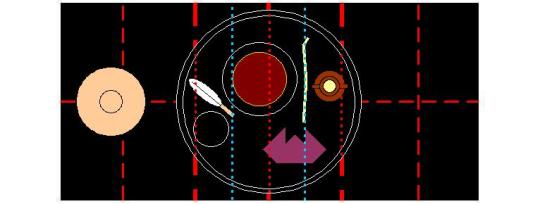
The temmoku overlaps the central kane by one-third, while the sasa-mimi and natsume contact the yang-kane to the right and left. The chashaku is placed on the yin-kane to the right of the central one, while the handle of the habōki only contacts the yin-kane on the left (thereby gathering the natsume with the temmoku, just as the fukusa also connects the chashaku with the temmoku).
Only the sasa-mimi is left by itself, indicating that it will be used to serve tea last -- not a mark of inferiority, but, as discussed previously (in the arrangements that focused on the use of this tea container that was a feature of the machi-shū practice), so that the guests could focus on the tea container.
The dai maru-bon will not be lowered to the mat until the last part of the temae, so that both the dai-temmoku and the sasa-mimi may be stood on the tray during the preparation and service of the second variety of tea. (The habōki is used to clean the dai maru-bon.)
⁴Temmoku dai ni noru [天目臺ニノル].
“The temmoku, mounted on [its] dai.”
⁵Kaku no gotoki chashaku kae-wan ni mo kumi-ire, kurushi-karazu [如此茶杓・カヘ碗ニモクミ入、不苦].
“If, in this way, the chashaku is also included with the kae-[cha]wan, there is no problem.”
⁶The complete Japanese texts of the kaki-ire are:
① shaku-naga midare mo onaji-koto nari, tadashi, shaku-naga ha shin, dai maru-bon ha gyō no kokoro to iu-iu, fukusa-mono ha chō-tatami nari, mesu-osu ari, ku-den
[尺長ミタレモ同事也、但、尺長ハ眞、大丸盆ハ行ノ心ト云〻、フクサモノハ蝶タヽミ也、雌雄アリ、口傳];
② dai maru-bon gyō no mono no yue, aru-toki ha jōdan ni kōbon ni kō-gu kazarite, cha-gu kazarazu, mei-kōro nado shōgan-suru toki nado ha, wanban no ato, chaire・chawan・chashaku・chakin・chasen maru-bon no uchi ni hitotsu ni okite hakobu-koto ari, kono toki temmoku fukuro ni iri, dai wo mo bon no uchi ni irete hakobi-dashi, kyaku mae ni te bon naka no cha-gu shikomi mo ari, mei-aru temmoku・chaire nado ha mu-yō nari, bon no mono taru-beshi, mata tsune no chawan nara ba shikomite, bon ni nose hakobu mo yoshi
[大丸盆行ノモノユヘ、アルトキハ上段ニ香盆ニ香具カサリテ、茶具カサラズ、名香爐ナト賞玩スルトキナトハ、椀飯ノ後、茶入・茶碗・茶杓・茶巾・茶筌丸盆ノ内ニ一ツニヲキテハコフコトアリ、コノ時天目袋ニ入、臺ヲモ盆ノ内ニ入テ運ヒ出、客前ニテ盆中ノ茶具仕込モアリ、名アル天目・茶入ナトハ無用ナリ、凡ノモノタルヘシ、又常ノ茶碗ナラハ仕込テ、盆ニノセ運フモヨシ];
③ mata chawan no naka ni ha natsume・chaire nari, ireko ni shi chakin・chasen ha midare ni shite, kyaku mae ni te shikomi-koto mo ari, kayō no koto ryōken shite ikuyō ni mo to iu-iu
[又茶碗ノ中ニハナツメ・茶入ナリ、入子ニシ茶巾・茶センハミタレニシテ、客前ニテ仕込コトモアリ、カヤウノコト料簡シテイクヤウニモト云〻].
⁷Shaku-naga midare mo onaji-koto nari, tadashi, shaku-naga ha shin, dai maru-bon ha gyō no kokoro to iu-iu [尺長ミタレモ同事也、但、尺長ハ眞、大丸盆ハ行ノ心ト云〻].
“Shaku-naga midare is the same thing [as this]. However, the shaku-naga is ‘shin,’ [while] the dai maru-bon gives a ‘gyō’ feeling, so it is said.”
⁸Fukusa-mono ha chō-tatami nari, mesu-osu ari, ku-den [フクサモノハ蝶タヽミ也、雌雄アリ、口傳].
“The fukusa-mono is folded [to resemble] a butterfly. There are female and male. There is a ku-den [related to this matter].”
Both Shibayama Fugen and Tanaka Senshō express bewilderment over this matter of this chō-tatami-kata [蝶疊み方] (Shibayama going so far as to state that he can make no sense of the drawing -- though the lack of detail in the drawing suggests that Tachibana Jitsuzan, too, had no idea of what to do) -- Tanaka, however, speculates that it might be the same thing as the way that the fukusa is folded in one of the secret temae taught by his school*. The actual tatami are shown below -- on the left is the mesu [雌] (female) chō-tatami [蝶畳み], while on the right is the osu [雄] (male) chō-tatami-kata [蝶畳み].

Be that as it may, the ku-den refers to both the two forms of the chō-tatami-kata [蝶畳み方] (how to fold the fukusa), and the occasions when the two different versions should be used.
As the first step in both of these, the fukusa is folded diagonally (as usual, before folding it for the temae), with the wa-sa [輪差] (the side that is folded rather than stitched, marked “ⒷⒸ” on the following sketches) on the right, and laid flat on the tray.
The mesu [雌] (female) form of the musubi is shown below (note that the corners “Ⓒ” naturally separate slightly when brought up, thus no special effort has to be made in this respect).
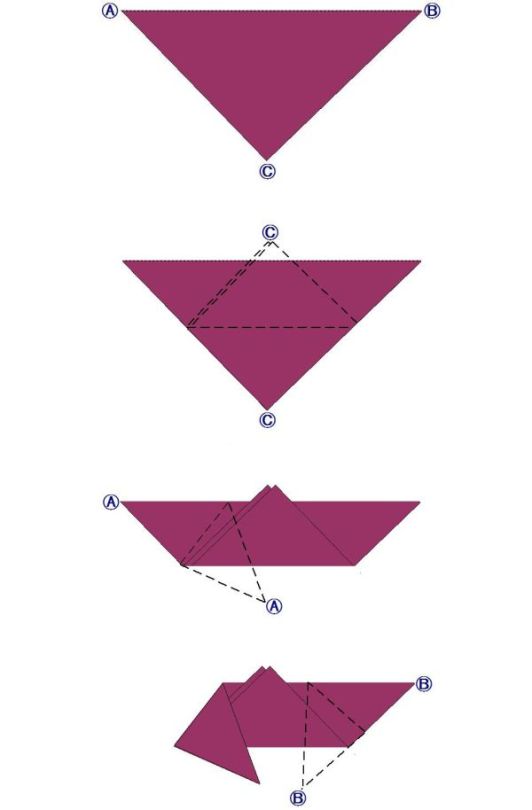
And the osu [雄] (male) form is folded as shown below.
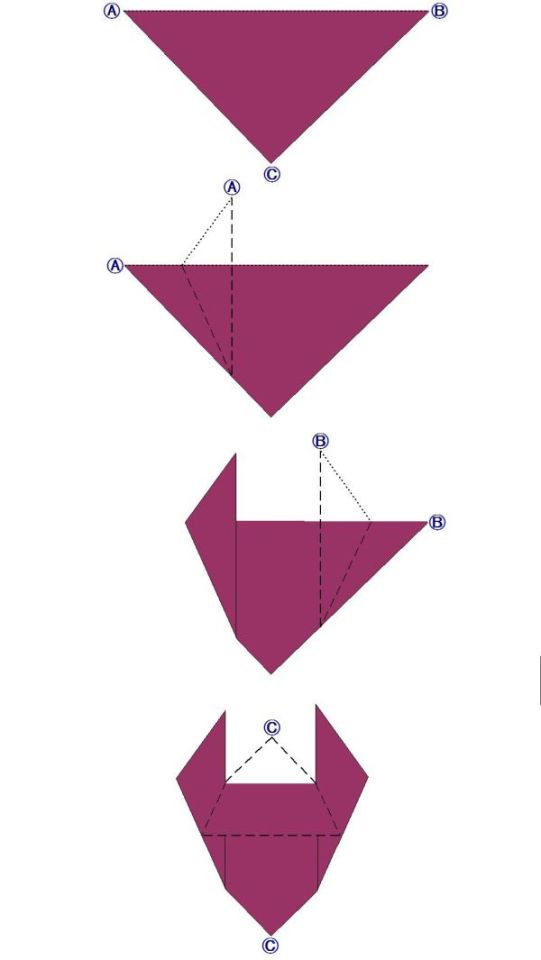
◎ The actual purpose of folding the fukusa in these ways is to keep the part of the cloth that will be used to wipe the tea utensils perfectly clean -- no matter how long the fukusa remains resting on the tray in this way -- by folding other parts of the fukusa over it.
◎ To lift the fukusa from the tray, the corner representing the tip of the right wing (“Ⓑ”) is picked up with the thumb below and the first finger above the corner. The fukusa will then fall into the usual triangular shape that can then be folded in the ordinary manner, before being tucked into the futokoro of the host's kimono†.
Finally, the ku-den concludes with the teaching that the fukusa should be folded in the “osu” form (osu, which means “male,” is yang) when tea will be served during the daytime, and in the “mesu” form (mesu, “female,” is yin) when tea will be served at night.
These ways of folding the fukusa probably originated with the Shino family, for the purpose indicated here.
The reader is asked to understand that while I have colored the fukusa purple, during the period when Jōō wrote his manuscript the temae-fukusa was made of Chinese donsu , of whatever color and pattern the host favored (and could afford), and its size was determined by the native width of the cloth‡.
__________
*This is not possible, however, since this is not a way that the fukusa can be folded during a temae. Rather, it is loosely folded on the tray in such a way that it can be easily picked up (and then refolded and so tucked into the futokoro of the host's kimono at the beginning of the service of tea). Folded in the manner shown, the fukusa could not be used to do anything.
†It must be remembered that folding the fukusa in the presence of the guests was a practice initiated by Rikyū. Theretofore, the fukusa was folded in the katte, and inserted into the futokoro, from where it was taken out to be used, and then returned immediately afterward.
Rikyū may have taken his inspiration from Shino Shōha [志野省巴; 1502 ~ 1571], who was one of his friends. Originally Rikyū folded the fukusa at the very beginning of the temae, immediately after the sō-rei. This would be similar to what is done here. (He later decided to follow Furuta Sōshitsu's suggestion that the folding of the fukusa be delayed until it was time to wipe the chaire, so that it would be cleaner. Oribe, meanwhile, took this idea from his own practice of using the little furoshiki in which a gift container of matcha was tied as the temae-fukusa when serving its tea.)
‡Purple fukusa of the size used today were created by Rikyū -- that is true -- not as a temae-fukusa, but as a furoshiki [風呂敷] (a wrapping cloth) in which a small natsume of gift tea was tied before it was sent off to the recipient. Purple was used because silk of this color was the most difficult (and so the most costly) variety of silk produced in Japan (at that time, the trade embargo with the continent was still in effect).
This kind of wrapping-cloth was first used as a temae-fukusa by Furuta Sōshitsu, when he unexpectedly received a gift of tea, from Rikyū, while officiating at a chakai. Deciding to share the tea with his guests (since it would never be fresher than when first received), he brought the natsume (tied in the little purple wrapping-cloth) into the tearoom. But, since he did not have a second fukusa (to keep them clean, the host usually only prepared as many fukusa as he would need for any given gathering; nevertheless, the rule was that a new fukusa had to be used for each different variety of tea that was being served at the gathering), Oribe suddenly got the idea to fold the wrapping cloth, and use that as a temae-fukusa to clean the natsume in which the gift tea was contained.
Finding the size extremely suitable for use as a temae-fukusa, Sōshitsu later made his own temae-fukusa in the same size.
As mentioned above, once Oribe decided to use the purple furoshiki as a substitute for a temae-fukusa, he was naturally unable to fold it until after he had removed it from the natsume. Subsequently reflecting on the day’s chakai afterward, he was inspired to delay folding the fukusa on ordinary occasions until after he removed the shifuku from the chaire, too, since doing so would insure that the fukusa was as clean as possible at this important point in the temae.
Rikyū approved of both of these innovations, and later incorporated both of them into his own personal temae.
⁹Dai maru-bon gyō no mono no yue, aru-toki ha jōdan ni kō-bon ni kō-gu kazarite, cha-gu kazarazu [大丸盆行ノモノユヘ、アルトキハ上段ニ香盆ニ香具カサリテ、茶具カサラズ].
“Because the dai maru-bon is a gyō object, on certain occasions when a kō-bon on which the incense utensils have been displayed is on the upper level, tea utensils should not be displayed.”
In the early days, a “kō-bon” [香盆] was not a specific kind of tray, as it is today, but referred to any tray of a suitable size that had sufficient room for the incense utensils.
While the tea things could be mingled with the incense things on the shaku-nagabon (because it is the shin [眞] tray -- and also because it is much wider), here, due to the lesser formality of the tray, it was sometimes felt that it might be better not to mix them on this kind of tray.
An example of when mixing the incense and tea utensils should be avoided is given next.
¹⁰Mei-kōro nado shōgan-suru toki nado ha, wanban no ato, chaire・chawan・chashaku・chakin・chasen maru-bon no uchi ni hitotsu ni okite hakobu-koto ari [名香爐ナト賞玩スルトキナトハ、椀飯ノ後、茶入・茶碗・茶杓・茶巾・茶筌丸盆ノ内ニ一ツニヲキテハコフコトアリ].
“When a famous kōro, or something like that, is being appreciated, and so forth, there is the case where, after the meal, the chaire, chawan, chashaku, chakin, [and] chasen are [arranged] on the maru-bon, placed as a unit, are carried out."
Hitotsu ni okite [一ツニヲキテ = 一つに置きて] means “placed together as one” -- that is, the entire collection of objects is considered to be a single unit. In other words, the various objects are assembled together on the dai maru-bon in the katte, and then carried out on the tray, which is then lifted up onto the ten-ita of the daisu.
This behavior will probably strike many of us as being contrary to the way things are “supposed” to be done in chanoyu. This is a clue that the temae was not created by someone who was focused on chanoyu (the Shino family was primarily concerned with incense).
¹¹Kono toki temmoku fukuro ni iri, dai wo mo bon no uchi ni irete hakobi-dashi [コノ時天目袋ニ入、臺ヲモ盆ノ内ニ入テ運ヒ出].
“At this time, the temmoku is inside its fukuro, and the dai has also be placed onto the tray when it is carried out.”
In other words, the temmoku, tied in its shifuku, is placed on the temmoku-dai, and this is stood on the tray along with all of the other utensils, and so it is carried out from the katte.
Again, this contradicts the way that people focused on chanoyu would usually behave (and, it is fair to point out that the way that tea people behave strikes the ordinary person in Japan as being incredibly weird, in general!).
¹²Kyaku mae ni te bon naka no cha-gu shikomi mo ari [客前ニテ盆中ノ茶具仕込モアリ].
“There is also [the case] where the tea utensils are assembled on the tray, in front of the guests.”
In other words, rather than arranging the various objects on the dai maru-bon in the katte, and then carrying the tray out in that way, it is also possible for the host to bring the tray out first, and then follow with the various other utensils, carried out one by one, and then arrange them on the tray while the guests are still sitting in the room.
Kyaku mae [客前] -- in front of the guests -- is the important phrase, because it is by doing this that the guests will be informed that tea will be served after a recess (rather than that they may leave for home after exiting the room -- as was originally done at incense gatherings).
Incense was best appreciated on an empty stomach, so it was appropriate for the host to serve his guests something afterward. However, including tea after a break appears to have been an innovation championed by the Shino family, and so not always expected (or, necessarily, desired) by many of their guests. Bringing out the tea utensils before the guests left the room would show what was to come, without making a special fuss about it (in case some of the guests preferred to depart immediately -- stating this aloud would seem to press them to stay, even if some had other business elsewhere).
We must remember that the “cha-kai” [茶會] had not been invented yet.
¹³Mei-aru temmoku・chaire nado ha mu-yō nari, bon no mono taru-beshi [名アル天目・茶入ナトハ無用ナリ、凡ノモノタルヘシ].
“A temmoku or chaire with a name, and so on, should not be used. Ordinary objects should suffice.”
A meibutsu temmoku, or meibutsu chaire must be handled carefully. Only ordinary objects could possibly be assembled on a tray, and then carried out from the katte as a unit, as described here.
This point must be understood clearly -- and the emphasis is necessary because the temmoku is tied in its shifuku (which ordinarily was done only when the temmoku was a special one). It is tied in its shifuku here because the temmoku (and the other tea things) is prepared at the beginning of the gathering, though kept in the katte until later. Returning it to its shifuku after washing it was seen as a way to keep it clean (since the preparation of the incense things in the katte often could result in dust flying around)*.
Once again, we must remember that we are seeing things through the eyes of someone for whom incense was the important thing, and everything is done to facilitate that particular activity (preparing everything at the beginning would allow the host to proceed seamlessly from the incense, to the meal, to the setting up of the daisu for tea, without having his guests sit wondering when they will be free to get up and rest their legs).
___________
*Perhaps it should not surprise us that Rikyū, for one, had a very different feeling about returning the temmoku to its shifuku before the temae.
¹⁴Mata tsune no chawan nara ba shikomite, bon ni nose hakobu mo yoshi [又常ノ茶碗ナラハ仕込テ、盆ニノセ運フモヨシ].
“Also if it is an ordinary chawan it may be [brought out after and] put together [with the other things]; or mounting it on the tray before [the tray] is carried out, is also acceptable.”
An ordinary chawan* might be brought later, and added to the things on the tray; or it might be placed on the tray in the katte, and brought out on the tray along with the rest of the tea things.
__________
*In the absence of a dai-temmoku. This chawan is not a kae-chawan, but the bowl in which the tea will be served.
While a dai-temmoku was sometimes used among equals, many people (including Rikyū) preferred to use it only when serving tea to a nobleman. Such people would prefer to substitute an ordinary chawan for the dai-temmoku on occasions such as then when a nobleman was not present.
¹⁵Mata chawan no naka ni ha natsume・chaire nari, ireko ni shi chakin・chasen ha midare ni shite [又茶碗ノ中ニハナツメ・茶入ナリ、入子ニシ茶巾・茶センハミタレニシテ].
“Or, again, inside the chawan might be the natsume or chaire. When [the tea container] is stacked inside [the chawan], the chakin and chasen should be scattered [apart from the chawan].”
If an ordinary chawan is used, rather than a dai-temmoku, and if the host decides to stack the natsume or chaire inside the chawan, then the chakin and chasen should be placed directly on the tray.
We must remember that the natsume was created by Jōō; thus, presumably, the Shino family used some other kind of tea container (and, the majority of those sanctioned for use before Jōō‘s time were ceramic chaire).
¹⁶Kyaku mae ni te shikomi-koto mo ari, kayō no koto ryōken shite ikuyō ni mo to iu-iu [客前ニテ仕込コトモアリ、カヤウノコト料簡シテイクヤウニモト云〻].
“This may also be done in front of the guests; but the end result should be as shown, regardless of how it is achieved, so it is said.”
In other words, regardless of whether the things are arranged on the tray in the katte and then carried out as a unit, or whether the tray is brought out first, and then the rest of the things are carried out separately and then arranged on the tray, the final result should always resemble what is shown in the sketch.
Carrying everything out as a unit is more efficient (the guests’ legs will probably be hurting by this point in the shoza), while carrying things out piece by piece shows more respect to the utensils.
However, since the point is to inform the guests that tea will be served after a recess, no matter how it is achieved, it is the impact of the arrangement on the guests that is necessary -- otherwise the guests might escape once they are released.
——————————————–———-—————————————————
◎ Analysis of the Arrangement.
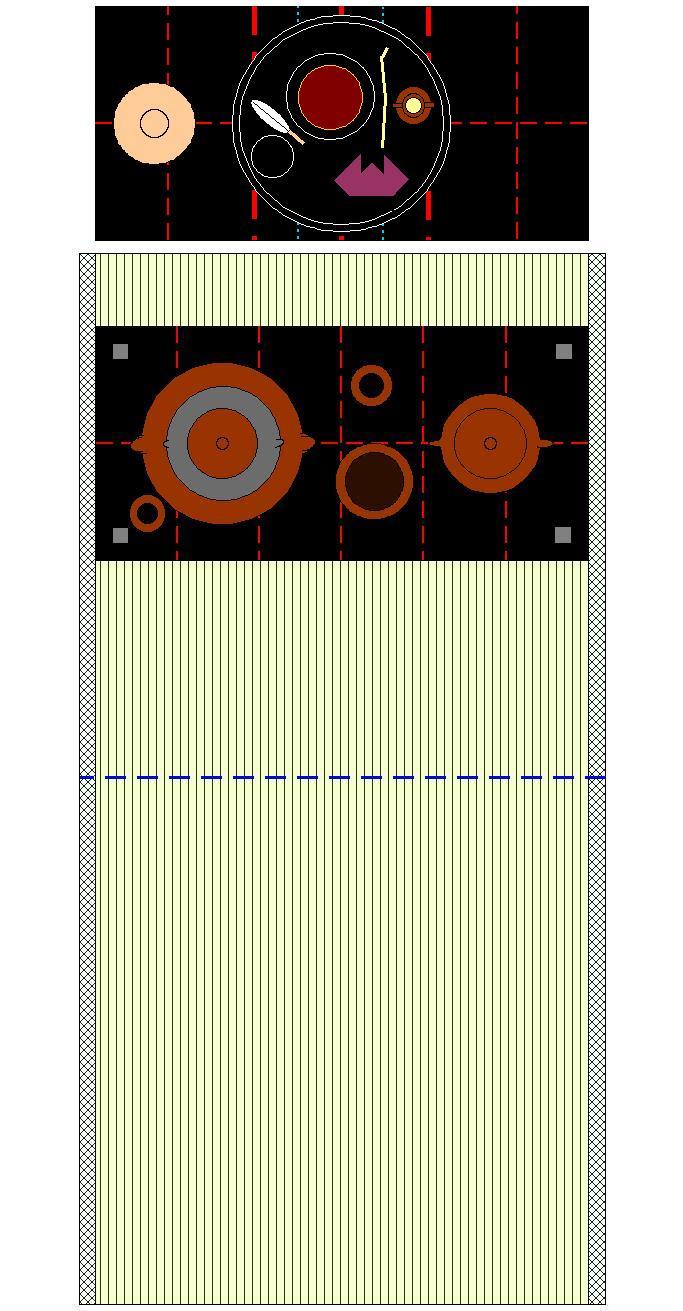
The habōki and fukusa gather the dai-temmoku, chashaku, and natsume into one group -- indicating that tea will be served from the natsume first*.
The tea in the sasa-mimi will be served later -- though whether as a second variety of koicha, or as usucha, depends on the host and his feelings regarding which kind of service his guests would prefer†.
__________
*The basic temae would resemble the same arrangement when the objects were displayed on the shaku-nagabon:
- the kae-chawan would be lowered to the mat first;
- then the fukusa would be picked up, folded, and inserted into the futokoro of the host's kimono;
- then the chashaku would be piced up and lowered to rest across the rim of the kae-chawan;
- then the dai-temmoku would be moved to the ten-ita, to the left of the tray;
- next the natsume would be lowered to the mat, and placed in front of the mizusashi as usual; and then the dai-temmoku lowered and placed beside it;
- then the sasa-mimi would be moved to the center of the tray, and the habōki placed either in front of it, or to its left.
Some see the centering of the sasa-mimi on the dai maru-bon (with the habōki placed either in front of it, or to its left) as following the precedent offered in entry 50 (where a taikai was displayed on either a naka maru-bon or a 1-shaku maru-bon, in this same way), and thereby use this as a way to demonstrate that entries 50 and 51 (along with the 3 “lost” arrangements) were an authentic part of Jōō’s manuscript. However, the inversion of this theory is equally possible: taking this secondary arrangement (which is not even mentioned in the annotation) as a sort of validation, the two entries in question could have been inserted where they were precisely because that would give them credence.
The dai maru-bon would be lowered to the mat when it is time to serve tea with the sasa-mimi (both the dai temmoku and the sasa-mimi will stand on the tray during the preparation of tea); the habōki is used to clean the tray.
†Both the natsume, and the sasa-mimi would be tied in their shifuku.
While, in the modern day, the usucha-ire is usually not tied in a shifuku, in the old days this was not done only when the tea it contained had been used previously (an example being that when Rikyū received guests after serving tea to Hideyoshi, while the utensils were all the same, the tea container was left without its shifuku -- since the tea it contained was what remained from his earlier gathering). When the tea it contained had been freshly ground for this chakai, however, the container of tea intended for usucha was tied in a shifuku as well as that prepared for koicha -- and this had been the precedent since the time of Yoshimasa (who occasionally served three kinds of tea during one session, particularly when cutting open a new cha-tsubo -- two kinds of koicha, and one usucha, representing the three varieties of tea typically sealed in each jar).
3 notes
·
View notes
Text
Flash flood, landslide still threaten Davao Region
#PHnews: Flash flood, landslide still threaten Davao Region
MANILA – Flash floods and rain-induced landslides will still threaten Region 11 (Davao) even if the weather there may begin improving on Friday (Jan. 8).
"Rainfall in Davao may lessen -- that's improving weather -- but can still trigger such hazards so people concerned must be alert to this possibility," said Philippine Atmospheric, Geophysical and Astronomical Services Administration (PAGASA) hydrologist Aileen Abelardo.
She noted that parts of Davao can be saturated already due to previous rains, making these areas prone to flooding and landslides.
New rain there may set off such occurrences, she said.
In its daily weather forecast on Thursday, PAGASA said cloudiness with scattered rain showers and thunderstorms are possible in Mindanao's Davao, Caraga and SOCCSKSARGEN regions due to the intertropical convergence zone (ITCZ).
Thunderstorms may also bring moderate to heavy rainfall that can cause either flash floods or landslides in those regions, noted PAGASA weather forecaster Raymond Ordinario.
He said weather in Mindanao may begin improving this Friday as the ITCZ will likely move away from the area.
He said the ITCZ may eventually move towards Mindanao's southeastern portion where Region 11 is. However, cloudiness, with scattered rain showers and thunderstorms are again possible there on Sunday (Jan. 10) and Monday (Jan. 11).
Generally, fair weather can be expected on both days in the rest of Mindanao since the ITCZ will likely affect the region's southeastern portion only, he noted.
According to PAGASA, rains may affect Region 11 waterways particularly Davao Oriental province's Cateel, Dapnan, Baganga Mahan-ub, Manorigao, Caraga, Casaunan, Quinonoan, Bagwan, Mayo, Bitanayan, Sumlog, Tangmoan, Dacongbonwa, Kabasagan, Manay, Maya and Sumlao/Cuabo; Davao City's Davao, Talomo and Lipadas, Davao del Sur province's Tagulaya Sibulan, Digos and Padada Mainit; as well as Davao Occidental province's Panglan, Malita, Batanan, Lais, Lawan, Latuan, Calian, Lamita, Lawayon, Culama, Caburan Bi, Maubio, Karabana, Tubayo, Kayapung, Malala, Capisolo, Tanoman Bi, Tanoman Smal, Kalbay, Butua, Nuin, Butula, Baki, Malagupo, Balagona and Batulaki.
Also likely to be affected are Davao de Oro province's Matiao and Hijo, as well as Davao del Norte province's Tagum-Libuganon, Tuganay, Saug and Lasang, PAGASA continued.
Abelardo said the ITCZ rain can raise water level in those waterways, possibly causing these channels to overflow.
The overflowing water will spill into areas near such waterways so flooding can occur there, she added. (PNA)
***
References:
* Philippine News Agency. "Flash flood, landslide still threaten Davao Region." Philippine News Agency. https://www.pna.gov.ph/articles/1126634 (accessed January 07, 2021 at 09:33PM UTC+14).
* Philippine News Agency. "Flash flood, landslide still threaten Davao Region." Archive Today. https://archive.ph/?run=1&url=https://www.pna.gov.ph/articles/1126634 (archived).
0 notes
Photo

[EUS] Garai batetik hona, talde batean aritzea ez da soilik musika egin eta zuzenean jotzea. Sareen bidez komunikatzea ezinbesteko bilakatu da, zalegoaren eta taldearen arteko distantzia laburtzeko xedez. Ez alperrik, dena zor diogu bestaldean dagoen jende horri. Jarraitzen gaituzuenok dagoeneko ohartuko zineten: aste osoan ez dugu gure sareetara ezer igo. Ez da itzalaldi digital bat, ezpada igandean Kobetamendin bizitakoak eragindako blokeo emozional moduko bat. Oraindik han gertatutakoa ezin asimilatuta gabiltza. Han eta hemen entzun/irakurritakoari erreparatuta, ematen du zaila izango dela han bildu ginenon oroitzapen gozoa luzaroan itzaltzea. Lorratza utziko duen mugarri kolektibo bat izan zen Bilbokoa. Hitzik gabe utzi gaituen zerbait. Horregatik, ez dakizunean jasotako maitasun hori guztia nola itzuli, leher eginda oheratu eta 20.000 lagunek zure kantuekin irri, negar, oihu, salto egin dutela gogoratzen duzunean... hobe da isilik geratzea. Miresten duzun 15 artistak bat egiten dutenean BTX-en karabana ibiltari horrekin, zuzeneko musikaren miraria piztu eta kantuek amiñi bat altuago hegan egiten dutenean; zure lantaldeak harro sentiarazten zaituenean, mundu guztia begira dagoenean akatsik egon ez dadin egiten duten esfortzuagatik... halakoetan hobe da isilik geratzea. Jotzen ari zarela begirada xingle bat nahikoa denean, esanez bezala “merezi izan dik egindako lan eskergak, bai horixe!”. Oholtzako sahietsera begiratu eta talde honengan lehendabiziko unetik sinetsi duen lagunak ikusterakoan -denbora den poligrafo erraldoi horrek arrazoiak banatu eta kendu baino askoz lehenago, dena ezereza zen une horietan, oro amets ero edo aieru zenean eta sabaiek kristal bikoitz zurrunezkoak ziruditenean-. Bai, halakoetan hobe da isilik geratzea. Honelako gau bat posible egin duten guztiei berriz eskerrak emateko besterik ez ireki ahoa. Eta datorrela hurrengoa. Helduko da lasaiago egin beharreko iruzkin eta analisietarako garaia. Kase.O -k esana da: ez dago gauzak ondo egitea baina promo hoberik. Ez dugu beste helbururik. Ahaldun gaitezen. Ez dadila haria eten #btxkobetamendi (📷 @gaizkapenafiel) (en Kobetamendi) https://www.instagram.com/p/B0DlLHHCToy/?igshid=15hl1xf93rbcq
0 notes
Text

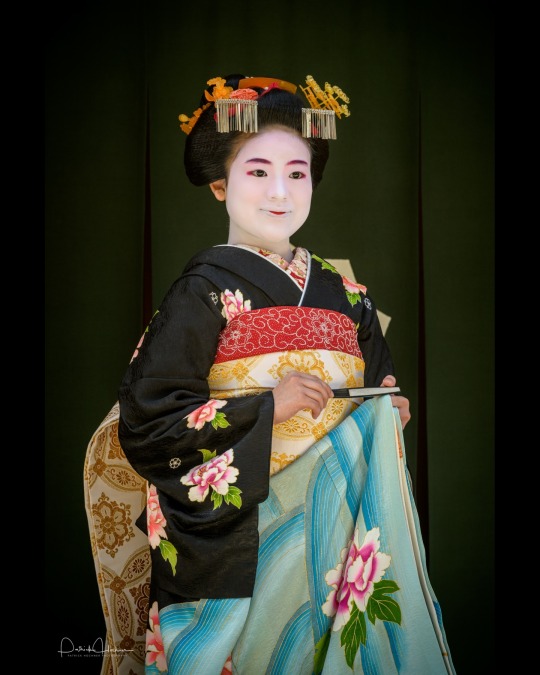
May 9th, 2024: Double congratulations are in order for Miyagawa Cho! Kotsuru (小つる) of Shigemori (しげ森) is celebrating her erikae while Fukunaru (ふく成), also of Shigemori, is celebrating her misedashi! Kotsuru is the first imōto of geiko Kofuku (小ふく), also of Shigemori, to be celebrating an erikae while Fukunaru is the eighth imōto of geiko Fukuhiro (ふく紘), also of Shigemori. Kotsuru's outfit features her namesake cranes flying above pine trees and water with a karabana obi while Fukunaru's outfit features peonies over waterfalls with a karabana and shippō obi ^^
おめでとうさんどす小つるさんとふく成ちゃん ^o^!
Images are courtesy of My Kyoto Photo [1] [2].
#maiko#geiko#geisha#kyoto#news#misedashi#erikae#miyagawa cho#debut#shigemori#kotsuru#fukunaru#舞妓#芸妓#芸者#京都#ニューズ#見世出し#店出し#襟替え#衿替え#ゑりかへ#宮川町#しげ森#小つる#ふく成
70 notes
·
View notes
Photo
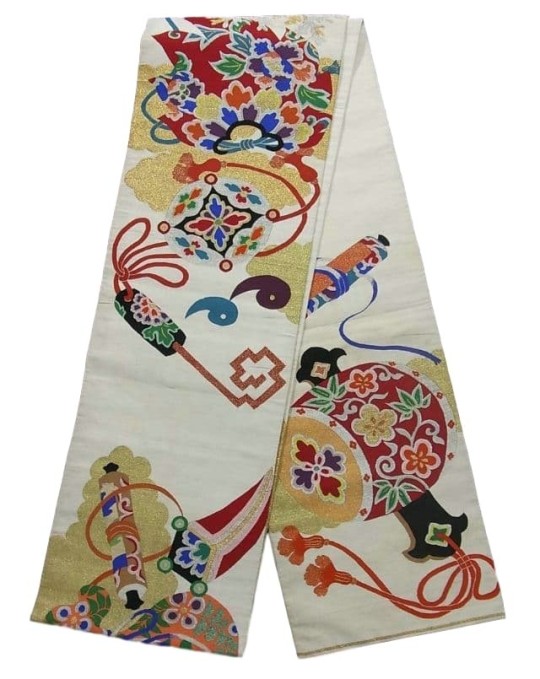
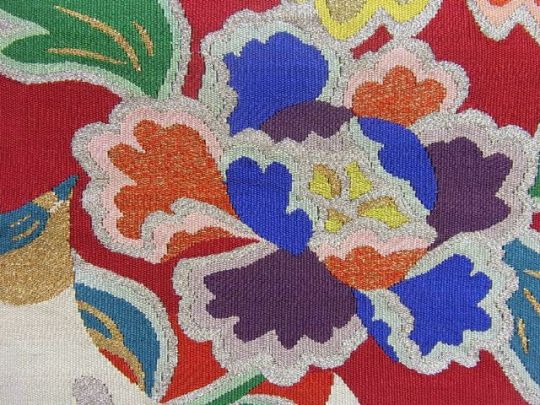
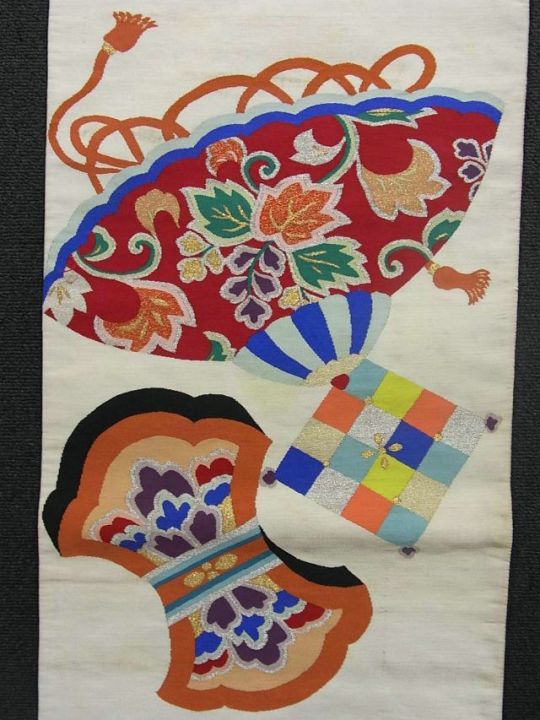

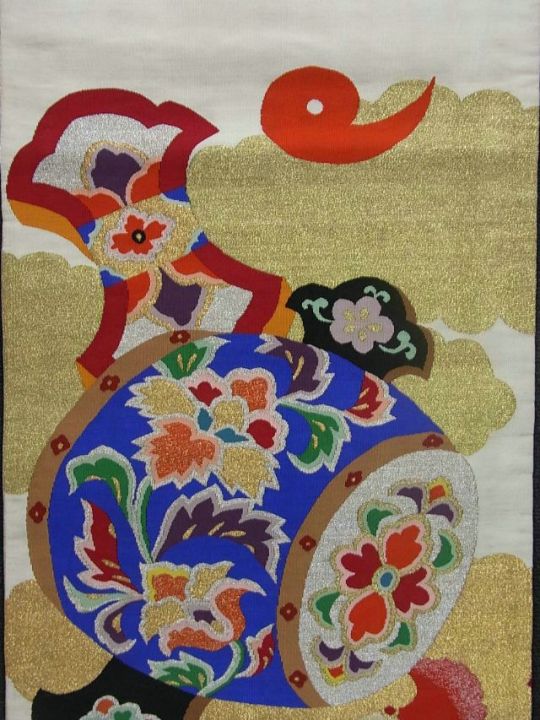

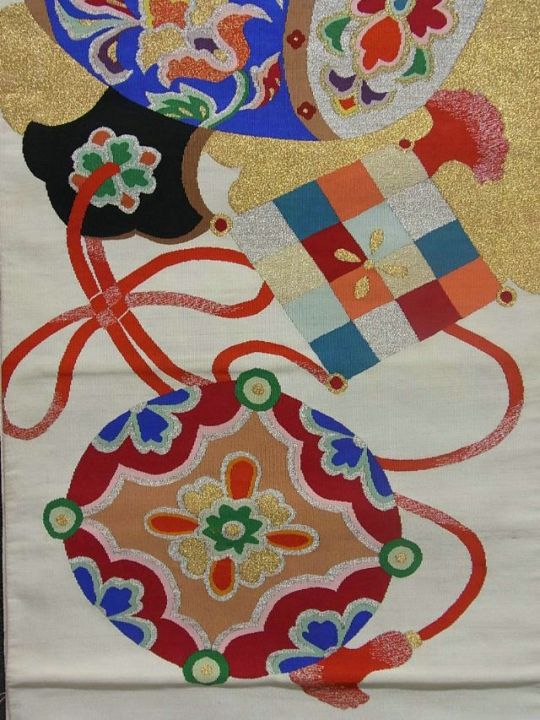


http://www.ichiroya.com Minokasa & Coral Design Vintage Tsume-Tsuzure Maru Ob
This is a vintage Tsume-Tsuzure Maru obi with a design of 'minokasa' (sedge hat), 'kiri'(paulownia), coral and 'karabana'(imaginary flower in China), which is woven.
Wrong side has a design of mallet, 'karabana'(imaginary flower in China) and scroll, which is woven.
Gold foil threads and silver foil threads are gorgeously shining on the pale base color.
One threads by one threads, it was woven elaborately with nails, and it had to be taken incredibly long time to be completed.
Textile is rather thick silk and has rather crisp touch.
Both sides are 'rokutsu'(approx 60% of the both sides are patterned).
0 notes
Video
vimeo
“BANNANA-CENTENARIA” Karabana: Music, karaoke and balas.-FeCal. Canción karaoke compuesta con la canción "banana" del grupo Garibaldi; la letra está basada en el discurso dado por Felipe Calderón durante el grito de Independencia conmemorativo al Centenario de la Revolución y al Bicentenario de la Independencia en México, 2010.
La identidad mexicana en sus diversas ficciones. 2012.
0 notes
Photo

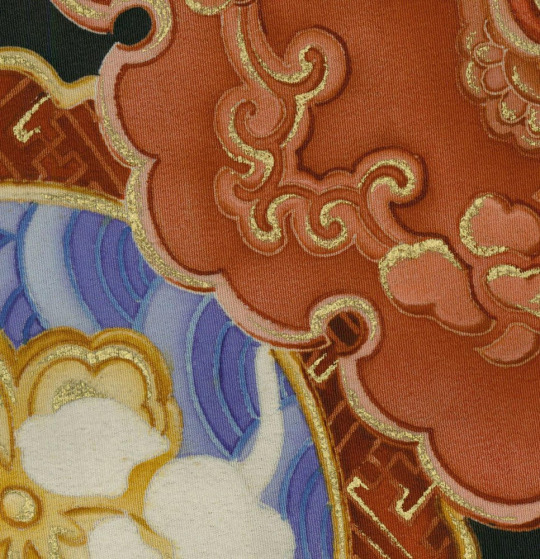
Yuzen-painted Kurotomesode
Mid-Showa period (1940-1960)
A kinsha (fine-crepe) silk kurotomesode featuring yuzen-painted "karabana" (imaginary flowers). Five mon (family crests). The yuzen-work on this garmnent involves careful shading, and includes profuse gold foil outlining.
98 notes
·
View notes
Photo

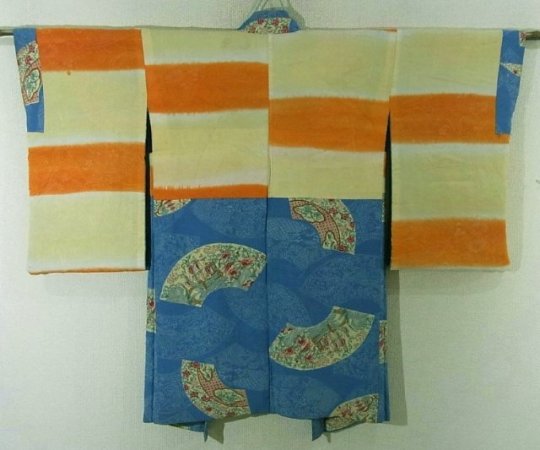
Koikishu’s Fantasy Kimono Tansu: Haori - Tomesode
Motifs: Fan-shaped Papers, Sailing Ship, Phoenix, Lions, Karabana (Imaginary Chinese Flower)
Seasonality: Seasonless
Sleeve Length: 60 cm
Background Color: HTML code 599AC2
Source: https://www.ichiroya.com/item/list2/476094/
22 notes
·
View notes
Link
El pasado 25 de mayo George Floyd fue detenido de manera extremadamente violenta por parte de agentes de policía de Minneapolis, su muerte vuelve a poner de manifiesto la expresión más atroz de un Racismo estructural e institucional que no cesa, que es insoportable, que no toleramos y frente al que nos levantamos con indignación y rabia. La imagen de su cuerpo violentado, tendido en el suelo clamando auxilio se suma a las miles de imágenes de violencia que atraviesa las vidas y los cuerpos de personas racializadas, que siguen categorizadas y empujadas a los múltiples márgenes que el sistema diseña para seguir justificando la opresión y el supremacismo.
Estas imágenes traen a nuestra memoria las de otra detención, también violenta, que se produjo en este mismo lugar donde hoy nos concentramos. Tenemos esa imagen grabada en nuestras retinas, recordamos a Elhadji Ndiaye tendido en el suelo y sobre él, a varios agentes de policía golpeándole hasta dejarle inconsciente y trasládándole a la comisaría donde moriría momentos después. Tras esto, recordamos silencios, justificaciones, intentos de archivo de su causa y más silencio; un silencio atroz de un sistema que nos quiere asimismo calladas, cómplices y víctimas, sin derechos. Es este sistema, representado por las instituciones, el que nos sigue etiquetando, categorizando y dividiendo, condicionando nuestros derechos a nuestro origen, género y racialización, creando espacios donde poder experimentar con los límites normativos y la exclusión.
Hasta hace pocas semanas, la movilidad en estas calles estaba restringida para controlar una pandemia, es imprescindible recordar que la movilidad y la libertad de las personas migradas y racializadas están restringidas de múltiples maneras todos los días del año; a través de un Racismo Institucional que toma forma de ley de extranjería y necropolítica migratoria, a través de los obstáculos en el acceso a derechos fundamentales, a través de controles de identidad racistas, que se convierten en antesala de detenciones violentas, internamientos en los CIE, expulsiones o la propia muerte.
Lo sucedido en Minneapolis nos recuerda lo urgente, imprescindible y transversal que es la lucha antirracista, y lo necesarias que son las redes de resistencia y apoyo mutuo, tejidas desde los márgenes, redes diversas y fuertes desde la que organizar la rabia y construir alternativas.
Nuestro grito de hoy se une al de todas las personas que se levantan contra el Racismo estructural, contra el Colonialismo, contra el supremacismo de quienes quieren seguir manteniendo un orden mundial basado en la jerarquización del poder.
#BlackLivesMatter #BizitzaDaHandiena #LasVidasNegrasImportan #DunduÑuuleAmnaSolo
Africa Unida, Flor de Africa, EH 11Kolore, Karabana Mugak Zabalduz, Papeles y Derechos Denontzat, Iruñea Harrera Hiria/Ciudad de Acogida y SOS Racismo Nafarroa
0 notes

